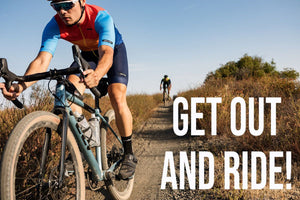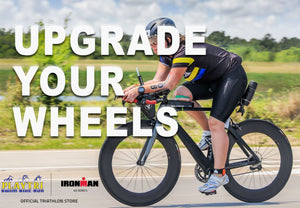Big Triathlon Coming Up? Make Sure You’re Race Ready!
By Coach Morgan Hoffman
Triathlon is as much about skill, logistics and problem-solving as it is about fitness. Unfortunately, it’s not uncommon to see athletes with great fitness have their big race go south due to problems that could easily have been prevented with a little intentional preparation. Following are guidelines to ensure that you get to race to potential on your big day!
1. First triathlon? Make sure to run through transition a few times prior to race day. How are you going to set up? What order will you grab things/put things on? Keep it as simple as possible – only the things you need to race should be in transition, and they should be laid out in an orderly fashion. The most important rule in transition is to keep a cool head and avoid rushing and getting flustered. On race day, after you set up transition, practice running to your spot from swim in and bike in to make sure you can find it quickly and easily during the race – look for landmarks nearby that you can find quickly upon entering transition.
2. Know when and where packet pick up is, and make sure you have a photo ID and proof of current USA Triathlon membership (or one day pass purchase) on hand when you go to pick up. USAT requires each athlete to pick up their own race packet, and to present a photo ID and proof of annual membership or one day pass purchase at the time of pick up. There are some exceptions - visit usatriathlon.org to learn more.
3. Are you doing a long course (70.3 or 140.6) event? Make sure you start dialing in nutrition and hydration at least 2-3 months in advance. Every long session is an opportunity to test, assess and adjust, so be intentional with your planning and take advantage of those opportunities by noting what works and what doesn’t. Consider getting metabolic testing and sweat testing performed (www.playtri.com/testing) to better understand and meet your body’s needs on race day.
4. Nothing new on race day! Make sure that anything you plan to use or do on race day is something that you have used or practiced prior in your training sessions.
5. The solution to every problem is to slow down. Triathlon is an endurance event (even when it’s called a sprint) and sucking it up for one minute could actually be the decision that derails the rest of your race. Learn to listen to your body, and consider using metrics like heart rate and power to let you know when you need to rein in the effort and allow your body to stabilize before pushing ahead.
6. Finally, get answers to the following questions about the course, and prepare accordingly with equipment, visualization and specific training before you leave for your race:
-
Will you be able to do a swim warm up prior to race start? If not, make sure you get some swim bands and have a plan for a dryland swim warm up. (We like the Finis swim bands)
-
Is the race open water? Get at least 4-5 open water swims (with a group, if possible) prior to race day. Pool swimming is NOT the same as open water!
-
Is the swim course known for cold temps? Purchase a wetsuit (we recommend going to your local shop and trying suits on prior to purchase as fits can vary widely by brand and model) and get at least 4-5 practice swims with the wetsuit, preferably in similar temperatures to make sure you identify any other pieces you may need (neoprene cap, ear plugs, etc.) prior to race weekend.
-
Does the swim course have you swimming into the sun? Get mirrored or polarized goggles to prevent vision impairment.
-
Is the swim course known for choppy conditions? Practice breathing to both sides so you can adjust the breath on race day based on the direction the water is coming from. Ask a friend to get in the pool with you and do our “annoying partner” drill – your friend swims next to you, constantly interrupting your stroke. Your job is to keep a cool head and practice maintaining form!
-
Is T1 on an unpaved surface? Plan to have bike shoes clipped to the bike (or carry them out) to avoid mud or other debris getting lodged in your cleats prior to the mount line, and plan to carry your bike to bike out to avoid flats caused by debris.
-
Does bike out tend to get crowded? Plan to stop and get on your bike (instead of performing a flying mount), and wait until you get out on the course to take nutrition/hydration, adjust your computer, get into your shoes (if you leave them clipped on the bike in T1), etc. Visualize yourself keeping your head up and holding the line until you’ve cleared the crowd – if possible, do some group rides with your race bike prior to race day.
-
Is there immediate elevation out of T1? Plan to put bike shoes on in transition if possible, and avoid flying mounts. Make sure your bike is in a reasonably easy gear so you are ready to start spinning as soon as get past the mount line.
-
What is the bike course terrain like? If it’s hilly, make sure you get plenty of hill workouts prior. If it has rough surfaces, make sure you practice riding on similar surfaces ahead of time. If the course is known for debris, consider putting a heartier tire on your wheels that will be less likely to flat.
-
What are temperatures like on the bike? If it’s known for being a fairly chilly race, don’t be afraid to pack appropriate gear and put jacket, gloves, etc. on in T1, especially if it’s a longer event. Better to spend an extra minute in transition than be unable to perform the entire bike. If the course is known for being hot and sunny, make sure shoulders and back are either covered or have a solid coat of sunscreen.
-
Is the bike windy? If winds are a common theme on the bike course, leave that disc wheel at home! Stick with shallower rim options, or if you’ve got a bigger budget select a wheel like the Zipp 454, whose ridged rim profile helps deflect cross winds more effectively than other race wheels of the same depth. Regardless of which wheel you choose to run, make sure you have at least a couple of practice rides in similar conditions to ensure that you’ve got the ride tool for the job.
-
Does the bike course get crowded? If so, make sure you get in some group rides on your race bike prior to race day. Review the drafting rules for the race you are in (note that Ironman and USA Triathlon have different guidelines), and remember that once you are overtaken on the bike, it is your job to create space behind the rider who has passed you. If you unintentionally end up in a pack, soft pedal and hold the line until the group passes. Are you the one doing the passing? Remember to announce your pass prior, and always pass on the left – be aware that all athletes may not be confident handlers, so give as much space as possible when passing, for your safety and theirs. Finally, on crowded courses, keep your temper on a leash and remember everyone paid to race. Be respectful of other riders.
-
What is the run course terrain like? If it’s hilly, make sure you get plenty of hill workouts prior. If it has rough surfaces or unpaved, make sure you practice running on similar surfaces ahead of time, and ensure you have footwear that can manage the demands of the day.
-
What are the temperatures on the run course? Cold run courses tend to be popular among athletes, and rarely require additional clothing (though a cheap pair of gloves that you can shove in your pocket halfway through may be a good investment for especially chilly events). However, hot and/or humid run courses, especially those lacking shade, require a bit more preparation. If your run course is known for bringing the heat, make sure you have a plan to cover back, shoulders, head and arms – this could be with apparel or sunscreen. We recommend wearing a technical hat (like our BOCO Playtri trucker) that you can fill with ice at aid stations to help keep cool. Plan to carry sodium replacement capsules to take periodically with water you pick up at aid stations, especially at long course events (for sprints and even Olympics you can likely stick with what they have at the aid stations).
-
Did you pay to do this race? Remember to ENJOY IT. Triathlon should be fun. Do your preparation so that race day is a celebration, not a source of stress. It’s normal to have some nerves, but don’t forget to soak up all that awesome race day energy, tell a stranger “you can do it,” and smile when you cross the finish line.
If you’ve still got questions, come by your local Playtri Store, or schedule a Free Coaching Consult at www.playtri.com/coaching to find out how we can help you achieve your goals on race day!




Leave a comment